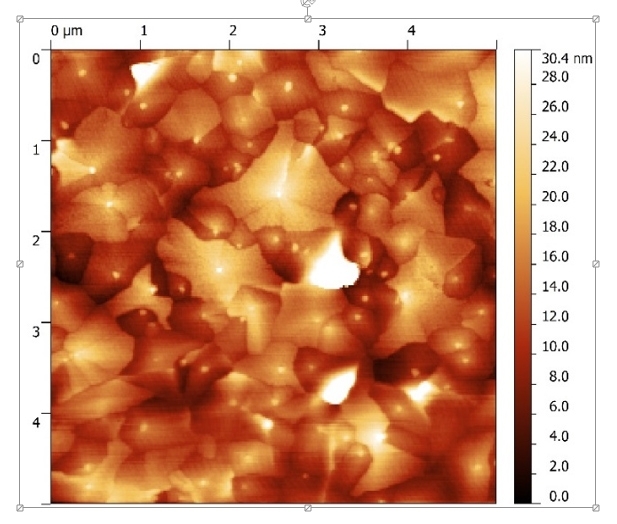


A titanium oxide nanofiber sheet was developed by a FAPESP-funded research group through electrospinning and atomic layer deposition (atomic force microscope image of TiO2 thin film of approximately 100 nanometers)
Published on 05/12/2021
By José Tadeu Arantes | Agência FAPESP – Titanium oxide (TiO2) nanofibers can have various applications, such as in catalyzers and filters. When TiO2 is excited by ultraviolet light, it degrades organic material. Hence, TiO2 can be applied to filter wastewater for reuse, for example.
A new method of fabricating these fibers has been developed in Brazil by Rodrigo Savio Pessoa and Bruno Manzolli Rodrigues, researchers at the Aeronautical Technology Institute’s Plasma and Process Laboratory (LPP-ITA) and the Science and Technology Institute of Universidade Brasil (ICT-UB), as part of a project supported by FAPESP. An article on the subject has been published in Materials Today: Proceedings.
“The technique we used is called atomic layer deposition. It promotes growth of the material layer by layer, or even molecule by molecule,” Pessoa told Agência FAPESP.
In the study, TiO2 was deposited on nanofibers of PBAT (poly (butylene adipate-co-terephthalate)), a biopolymer that degrades rapidly in nature, unlike PET (polyethylene terephthalate), which remains intact for decades.
The first step was to produce a membrane of PBAT nanofibers, which was done by electrospinning, a technique similar to that used to make cotton candy, but involving an electrostatic procedure.
“A PBAT solution was electrospun to produce ultrathin nanofibers only a few hundred nanometers thick. These fibers made up the sheet used as a substrate,” Pessoa said.
The next step was to coat each fiber with TiO2. “Atomic layer deposition uses precursors of the material of interest produced from gas or liquid that’s rapidly evaporated by low pressure. In this case, we used titanium tetrachloride (TiCl4) and water (H2O) as precursors. This was done in a vacuum chamber heated to 100 °C and 150 °C,” he explained.
The TiCl4 was released in successive pulses of 0.25 seconds. When released in a vacuum, TiCl4 quickly evaporates and reacts with the surface of the fibers, binding to hydroxyl radicals (OH-) and oxygen radicals (O2-) present in the material.
Because TiCI4 does not react with itself, the initial pulse filled only one layer, which was then oxidized with steam. Hydrogen bound to the chlorine and oxygen bound to the titanium, forming the first monolayer of TiO2.
This procedure was repeated approximately 1,000 times, building up the TiO2 structure layer by layer. To remove the PBAT substrate and free the TiO2 nanotubes, the material was heated to 900 °C in a controlled manner. The result was a sheet of TiO2 nanotubes with a thickness of approximately 100 nanometers.
“The deposition technique is based on surface reactions and therefore results in an even coating, covering the fibers one by one. It’s relatively simple but requires automation so that the amount of material and dispersal time are rigorously controlled,” Pessoa said.
As a material for filtration, the sheet of TiO2 nanotubes combines the mechanical virtue of blocking particles larger than a specific size with the biochemical virtue of generating radicals that easily degrade organic matter when irradiated with UV light. Because the sheet is made of nanofibers, it has a large surface area, which considerably increases the reaction rate.
The article “Atomic layer deposition of TiO2 thin films on electrospun poly (butylene adipate-co-terephthalate) fibers: Freestanding TiO2 nanostructures via polymer carbonization” (doi: https://doi.org/10.1016/j.matpr.2019.02.003) by Bruno V. M. Rodrigues, Vanessa M. Dias, Mariana A. Fraga, Argemiro S. da Silva Sobrinho, Anderson O. Lobo, Homero S. Maciel and Rodrigo S. Pessoa can be retrieved from: www.sciencedirect.com/science/article/pii/S2214785319300380.
Source: https://agencia.fapesp.br/31313